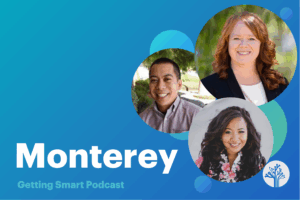NCTAF Learning Studios: The Future of Learning

Every once in awhile, we see pictures of the future — a graphic image, a set of relationships, new tools at work, the buzz of a culture that feels remarkably productive. For me, site visits to Big Picture and Edvision schools were really influential 12 years ago — and why I’m still enthusiastic about flex school models that engage and empower students.
I’m worried that so much science instruction is a boring, compartmentalized Trivial Pursuit. That’s why I’m a big fan of research projects and science fairs. I’m a fan of interdisciplinary studies (and interdisciplinary school models like this one).
That’s why I was encouraged to hear that before school started this fall, about 40 educators from Howard County Public Schools met to develop authentic learning situations for their students as part of National Commission on Teaching and America’s Future’s (NCTAF) Learning Studios Program–a program that helps teachers construct community connected yearlong investigations.
Here’s the bet
IF authentic, Project-Based Learning (PBL) for students is collaboratively designed by high-functioning, multi-subject Professional Learning Communities (PLC), in partnerships with the content expertise, resources, and coaching supports of Outside Content Experts (OCE)…
THEN students and teachers will be more engaged in excellent teaching and deeper learning.
A Centennial High School, Learning Studios transformed science education. With the support of teachers and scientists, students worked in groups on a climate change project with at least one student from every STEM discipline.
“The science students provided background on climate change, the technology students built the flash websites, the engineering students assisted in project management and design process of the project, and math students graphed data showing changes in global temperatures and CO2 levels over time,” said Tom Carroll of NCTAF. Students presented and defended their results.
There are three powerful design aspects to Learning Studios:
- It is challenge-based and encourages year-long project investigations
- It it incorporates interdisciplinary cross-curricular teams; and
- It is a collaboration of teachers and STEM professionals.
Learning Studios combines learner-centered, standards-based, and teacher-supported experiences. The student learning objects include learning to know more, learning to do more, and learning to create more. And it looks like it’s working.
Carroll joined the NCTAF a decade ago after a career blending technology, teaching and service. Carroll’s training as cultural anthropologist makes him an astute observer of how schools change.
“Unlike prepackaged science programs, teachers are actively involved in designing projects,” said Carroll. “Teachers are doing project-based learning (PBL) with their students.”
Learning Studios incorporates local STEM professionals to help design a year long inquiry
broken up into modules and executed on quarterly basis. Learning Studios projects in Maryland high schools have explored earthquakes, energy consumption, and water quality.
Early indications are that Learning Studios students outperform non-Learning Studios students, especially on constructed response assessments. NCTAF has just received funding to significantly expand its evaluation of student impact and will have more to report soon. Evaluators also note higher levels of student engagement and see Learning Studios students taking more STEM courses. They expect to see more students pursuing STEM in higher ed.
Carroll calls Learning Studios “a different way to teach and learn.” I call it a picture of the future.
For more, see recent blogs on Maryland Learning Studios:







0 Comments
Leave a Comment
Your email address will not be published. All fields are required.